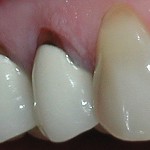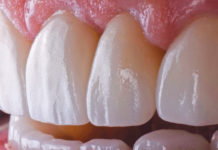
Over the past dozen or so years, several new crown and bridge materials have come onto the market. While they have significantly raised esthetic standards, however, the materials have posed a challenge. Most are limited in their suitability for many situations commonly encountered in clinical practice.
Enter Captek, a traditional PFM restoration material that is breaking new ground. Whereas this type of material has increasingly taken a back seat in the new wave of esthetics, Captek retains every PFM advantage and provides unsurpassed esthetic results. It’s the perfect material for restoring crowns and bridges.
Captek is a composite metal, not an alloy. When used as a porcelain substrate, it virtually duplicates the optical properties of enamel’s underlying tooth structure. In my experience, with factors like lab technician skills and the quality of clinical records being equal, it may be easier to attain the highest level of esthetics using all-ceramics. But in the hands of superior ceramists like the Elite porcelain team at Arrowhead, Captek can also achieve an ultimate vitality.
Captek’s strength, toughness, and masking ability make it applicable under more conditions than many of its metal-free counterparts. These conditions include occlusal loads, parafunctional habits, discolored tooth structure, and margin placement. Thus, Captek has become the mainstay of my crown and bridge practice since I first used it in early 2002.
Clinically, I choose Captek for cases where structural forces may still be problematic, even after occlusal therapy. I use it when I’m hesitant to use all-porcelain restoratives. Also, Captek is appropriate for short- and long-span bridges anywhere in the mouth, while most metal-free materials are not recommended for bridgework behind first premolars. Discoloration of the underlying tooth structure is common in non-vital teeth. With the exception of Zirconia, the discoloration can reflect through all-ceramics, compromising the resulting esthetic outcome.
Zirconia’s strength is superior to that of other all-ceramics, making it conventionally cementable. Another benefit is that it will camouflage the darkening often seen in non-vital teeth. Ultimately, however, I have found Captek’s strength superior to that of Zirconia, whose esthetics are the least life-like of this new generation in materials. Most other metal-free indirect restorations are bonded, whereas Captek units can also be conventionally cemented.
 When clinical circumstances such as location or new decay dictate that margins be placed subgingivally, this becomes a distinct advantage. Captek’s unique bacteriostatic properties promote periodontal health, and studies have shown that surrounding gingivae appear more natural with Captek crowns than other restorative materials.
When clinical circumstances such as location or new decay dictate that margins be placed subgingivally, this becomes a distinct advantage. Captek’s unique bacteriostatic properties promote periodontal health, and studies have shown that surrounding gingivae appear more natural with Captek crowns than other restorative materials.
Earlier in my career, I was often frustrated when my perfectly placed margins became exposed in a few years by angry-looking gingivae in a clean mouth (fig. 2). Since I started using Captek, such cases have become virtually absent from my practice (fig. 3).
 In short, Captek is my crown and bridge restoration of choice. Applicable in nearly all situations, it more than measures up to any other in terms of soft tissue compatibility, lifelike esthetics, and long-term function. And by the way, the tooth restored with a Captek crown in fig. 1 is #13.
In short, Captek is my crown and bridge restoration of choice. Applicable in nearly all situations, it more than measures up to any other in terms of soft tissue compatibility, lifelike esthetics, and long-term function. And by the way, the tooth restored with a Captek crown in fig. 1 is #13.










